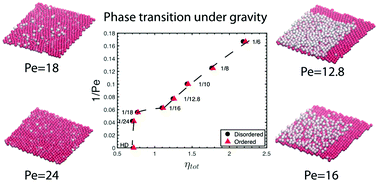Ordering of colloidal hard spheres under gravity: from monolayer to multilayer†
Abstract
The phase behaviour of hard spheres confined by a gravitational potential to a thin layer (up to several monolayers) near a hard, flat surface is investigated using grand canonical Monte Carlo simulation. Depending on the strength of the gravitational field, the bottom monolayer of spheres may adopt uniform hexagonal order before, during, or after the growth of the second layer of particles. The crossover from ordering with a sparsely populated overlayer to ordering with almost one-third of the system's particles forming a second layer is observed upon decreasing the dimensionless Péclet number Pe = mgσ/kBT from 18 to 16. The particular sensitivity of the nature of the transition to particle size in this range is interpreted in terms of competing influences on the base layer structure by particles in the overlayer: promotion of order through increased pressure, versus stabilization of defects through occupation of low-lying sites on top of them. Simulations of grain boundaries between 2-D ordered domains of different orientation are used to correlate the degree of overlayer coverage to its effects on grain boundary stiffness as an indicator of defect free energy. Finally, we examine the structure of the ordered phases at coexistence over a range of gravitational strengths and find that orientational ordering of the second monolayer occurs along with first-order transition of the base layer at Pe = 8 but not at Pe = 10.



 Please wait while we load your content...
Please wait while we load your content...